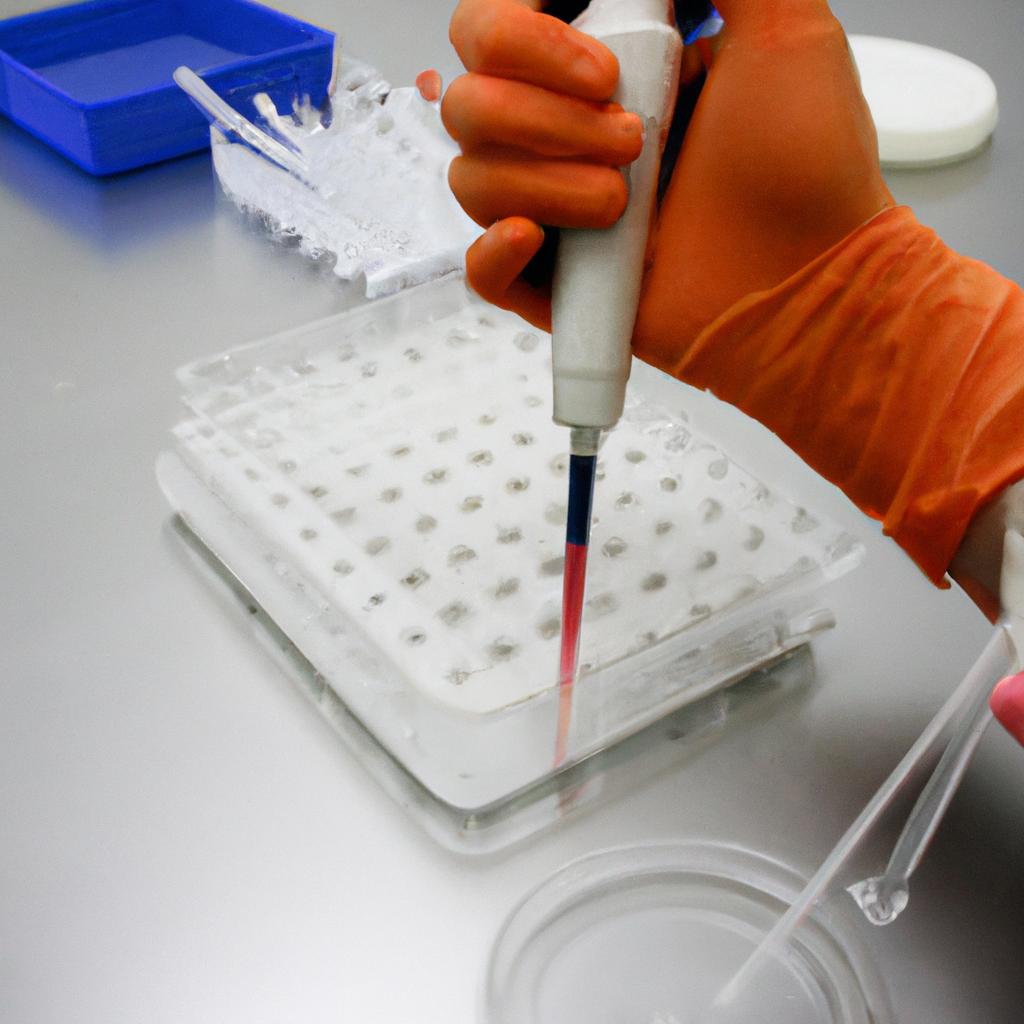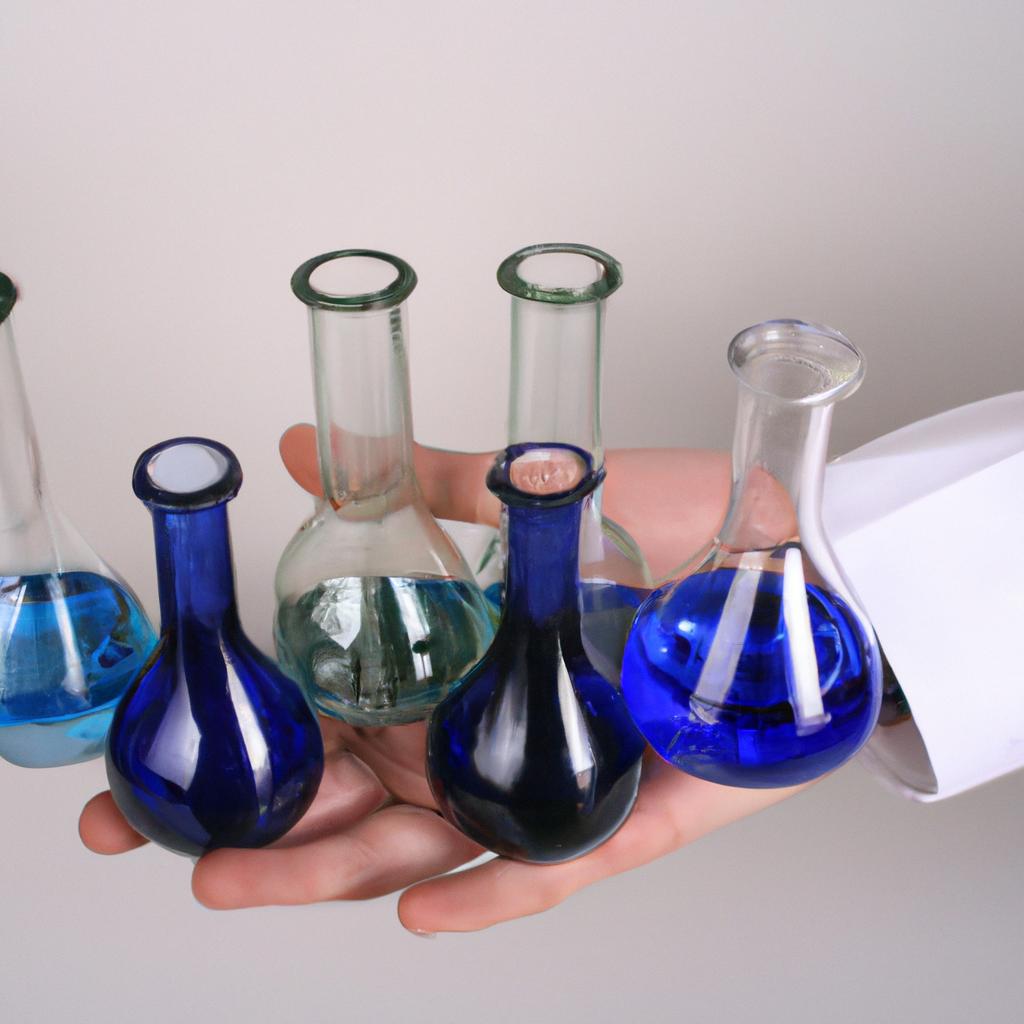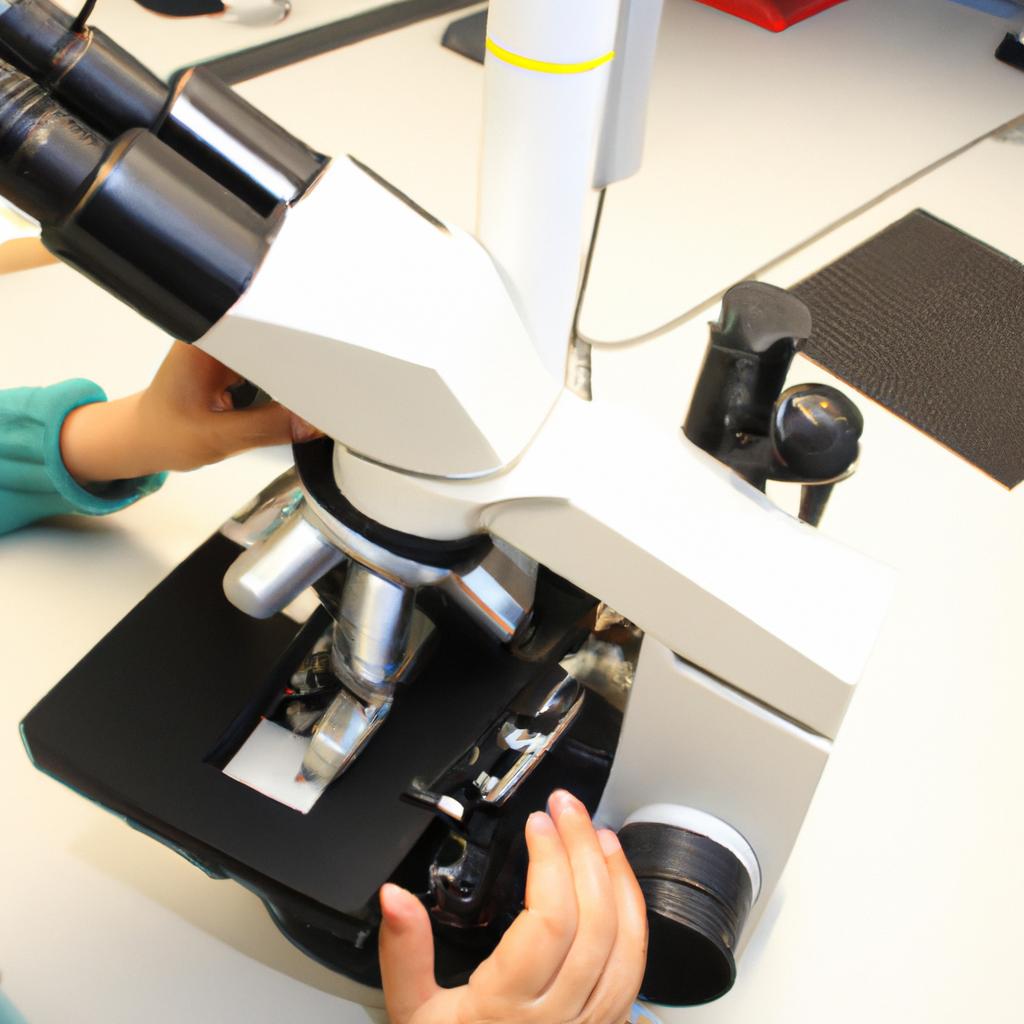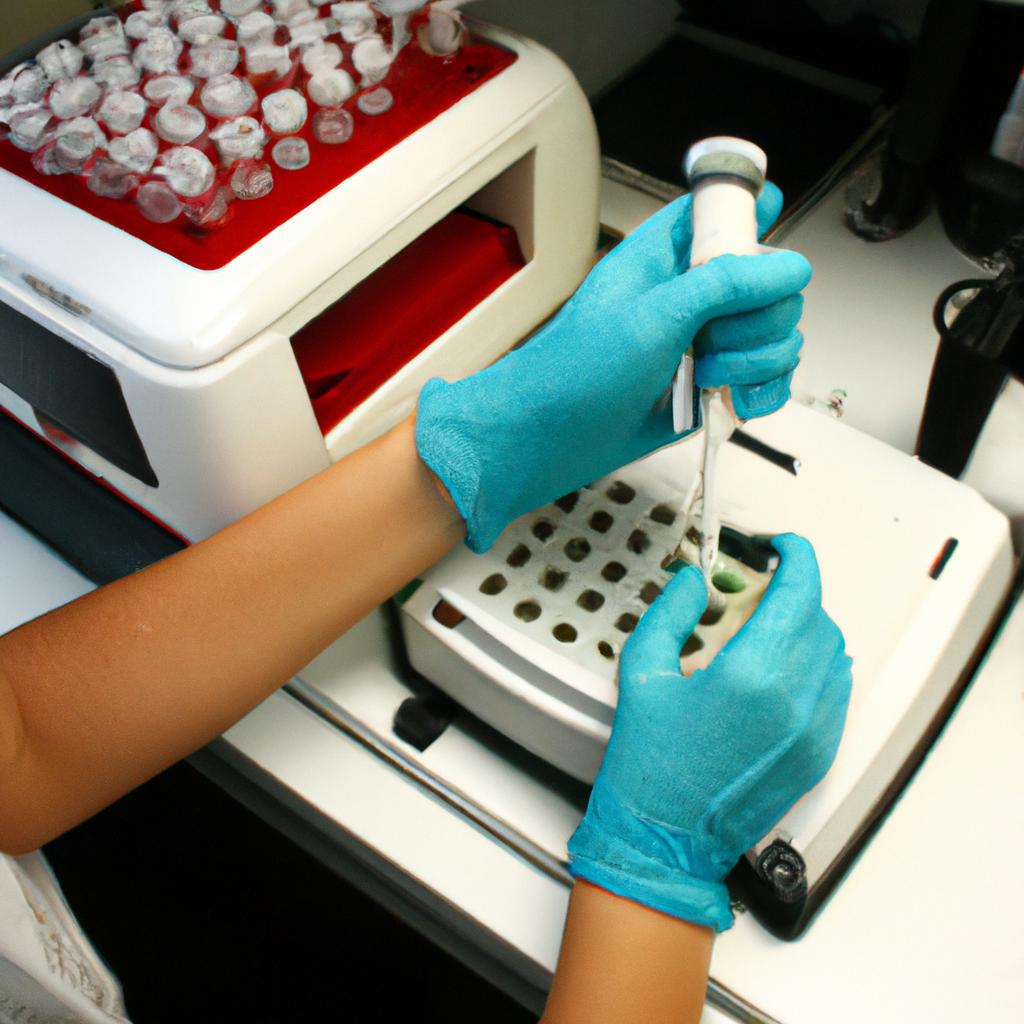Pipettes: A Guide to Lab Equipment in Instruments and Supplies
Imagine a scenario where a researcher is meticulously measuring small quantities of liquid for an experiment that could potentially revolutionize the field of medicine. In this critical moment, precision and accuracy are paramount, and no other instrument can match the reliability of a pipette. The utilization of pipettes as indispensable tools in scientific laboratories cannot be overstated. This article aims to provide an in-depth understanding of these instruments by exploring their different types, functions, calibration procedures, and maintenance requirements.
In the realm of laboratory equipment, pipettes hold a central position due to their ability to dispense liquids with remarkable accuracy and reproducibility. Whether it is transferring minute volumes or aspirating precise amounts from one container to another, researchers heavily rely on pipettes to ensure experimental integrity. Understanding the various types of pipettes available today – such as volumetric, graduated, serological, micropipettes, and electronic models – is crucial for selecting the most appropriate tool for specific applications. Moreover, learning about proper calibration techniques not only guarantees reliable results but also enhances overall experimental efficiency. Lastly, regular maintenance practices play a pivotal role in extending the lifespan of pipettes while minimizing potential error sources. By delving into By delving into the intricacies of pipettes, researchers can optimize their laboratory processes and improve the accuracy and precision of their experiments. Calibration procedures, such as gravimetric or spectrophotometric methods, ensure that the pipettes are dispensing accurate volumes, preventing any potential biases in the results. Regular maintenance practices, including cleaning and lubrication, help to keep the pipettes in optimal working condition and prevent contamination or malfunctions.
Furthermore, understanding the various features and specifications of different types of pipettes allows researchers to select the most suitable instrument for their specific needs. Volumetric pipettes are ideal for precise measurements of fixed volumes, while graduated pipettes offer flexibility in measuring variable volumes. Serological pipettes are commonly used in cell culture applications due to their ability to dispense small increments accurately. Micropipettes are designed for extremely small volume measurements and are often used in molecular biology experiments.
Electronic pipettes provide additional convenience and automation with features like programmable settings and digital display screens. They offer improved ergonomics and reduce user fatigue during repetitive tasks.
In conclusion, a comprehensive understanding of pipettes is essential for any researcher looking to achieve reliable results in their lab work. By exploring the different types available, learning about calibration techniques, and implementing regular maintenance practices, scientists can rely on these instruments to deliver accurate measurements consistently. With proper utilization of this invaluable tool, researchers can push boundaries and make groundbreaking discoveries in medicine and beyond.
Understanding Pipettes
Imagine you are a scientist in a bustling laboratory, working on groundbreaking research. One of your key tools is the trusty pipette, an instrument that allows precise measurement and transfer of liquids. Whether it’s handling small volumes or ensuring accuracy in experiments, pipettes play a vital role in scientific investigations.
To fully grasp the significance of pipettes in the lab setting, let us explore their various features and functions. First and foremost, pipettes come in different types, each suited for specific purposes. From air displacement to positive displacement pipettes, these instruments offer versatility and precision when it comes to liquid manipulation.
Now let’s delve into why understanding the principles behind pipetting techniques is crucial for any researcher. Accurate measurements form the foundation of reliable experimental results. By mastering proper pipetting methods, scientists can ensure reproducibility and minimize errors caused by imprecise volume delivery.
To illustrate this point further, consider the following emotional bullet points:
- Precise measurements: Achieving accurate results requires meticulous attention to detail.
- Reproducibility: Reliable data leads to more robust conclusions.
- Error reduction: Minimizing mistakes enhances credibility within the scientific community.
- Time efficiency: Proper use of pipettes saves valuable time during experiments.
In addition to considering these factors, researchers must also familiarize themselves with other aspects related to pipetting techniques. This includes selecting appropriate tips based on sample properties (e.g., viscosity), calibrating instruments regularly for optimal performance, and practicing good ergonomic habits while using them.
To summarize our discussion on understanding pipettes, we have explored their importance as indispensable tools in laboratories worldwide. By carefully considering various factors such as liquid type, technique precision, error reduction practices, and equipment maintenance protocols; researchers can harness the true potential of these versatile devices.
With a solid foundation established on comprehending general concepts about pipettes’ design and purpose; we can now move forward into the subsequent section, which delves into the different types of pipettes. By doing so, we will gain a deeper understanding of how these instruments cater to specific scientific needs and contribute to the advancement of knowledge in various fields.
Types of Pipettes
In the previous section, we explored the fundamentals of pipettes and their importance in laboratory settings. Now, let’s delve deeper into the various types of pipettes available and how they can be utilized for different applications.
Imagine a scenario where a research scientist is working on developing a new drug formulation. They require precise measurements to ensure accurate dosage calculations. In this case, using a micropipette would be ideal due to its ability to dispense small volumes ranging from 0.1μL to 1000μL with high precision.
When it comes to selecting the right pipette for your needs, there are several factors to consider:
- Volume Range: Different experiments may call for varying volume ranges. Whether you need to handle microliters or milliliters, choosing a pipette that covers your desired range is crucial.
- Accuracy and Precision: Accurate and precise measurements are essential in any scientific endeavor. Look for pipettes that have been calibrated and verified for accuracy.
- Ergonomics: Laboratory work often involves repetitive tasks that can lead to strain and discomfort. Opting for ergonomically designed pipettes can reduce hand fatigue and enhance user comfort.
- Compatibility: Ensure that the chosen pipette is compatible with the type of liquid being handled as well as other necessary accessories such as tips and tubes.
To further illustrate these considerations, here is an example table outlining some common types of pipettes along with their respective volume ranges and features:
| Pipette Type | Volume Range (μL) | Features |
|---|---|---|
| Micropipette | 0.1 – 1000 | High precision dispensing |
| Serological Pipette | 1 – 50 | Graduated markings for easy measurement |
| Volumetric Pipette | Up to 10 | Designed for highly accurate transfers |
| Multichannel Pipette | 1 – 300 | Simultaneous dispensing for increased efficiency |
By carefully considering these factors and using the appropriate pipette, researchers can ensure accurate and precise measurements in their experiments.
With a clear understanding of different types of pipettes, let’s now move on to discussing the important aspects one should consider when choosing the most suitable option for their unique laboratory needs.
Choosing the Right Pipette
Section Title: Types of Pipettes
Building on our understanding of pipettes, let’s now explore the different types available in laboratories. To illustrate their practical use, consider a hypothetical scenario where researchers are analyzing DNA samples for genetic mutations. In this case, they would require various types of pipettes to accurately transfer small volumes of liquid.
Types of Pipettes:
-
Volumetric Pipettes:
- Designed for precise measurement and delivery of fixed volumes.
- Commonly used in analytical chemistry and pharmaceutical research.
- Ideal for preparing standard solutions with high accuracy.
- Bulbous at the top and tapered towards the tip, ensuring proper drainage.
-
Micropipettes:
- Used when working with microliter volumes (µl) or even smaller quantities.
- Widely employed in molecular biology experiments, PCR setups, and enzyme assays.
- Available as adjustable or fixed-volume variants depending on experimental needs.
- Equipped with disposable tips to avoid cross-contamination between samples.
-
Serological Pipettes:
- Primarily used for transferring larger volumes ranging from 1 ml to 50 ml.
- Feature graduation marks along their length for accurate volume assessment.
- Often utilized in cell culture work, media preparation, and reagent dispensing.
- Can be either sterile or non-sterile based on specific laboratory requirements.
-
Pasteur Pipettes:
Advantages Disadvantages Flexible Not suitable for precision Disposable option Limited volume range Cost-effective Challenging to control flow
In summary, choosing the appropriate pipette is crucial for achieving reliable results in scientific investigations. Researchers must carefully evaluate their experimental requirements before selecting the type best suited to their needs. In the subsequent section, we will delve into proper pipetting techniques to ensure accurate and reproducible measurements.
Proper Pipetting Techniques
Choosing the right pipette is crucial for accurate and precise laboratory work. In the previous section, we discussed various factors to consider when selecting a pipette, such as volume range, accuracy, precision, and ergonomics. Now, let us delve into the proper techniques of pipetting that will help ensure reliable results in your experiments.
To illustrate the importance of proper pipetting techniques, let’s consider an example: Dr. Smith is conducting a series of PCR reactions that require meticulous handling of small volumes. Despite using high-quality reagents and following the protocol diligently, Dr. Smith consistently obtains inconsistent results with varying yields. Upon closer examination, it becomes evident that improper pipetting techniques might be responsible for these discrepancies.
To avoid similar issues, here are some key points to keep in mind while performing pipetting:
- Maintain a consistent angle: Hold the pipette at an angle between 20° and 45° to ensure optimal dispensing accuracy.
- Avoid air bubbles: Expel any trapped air bubbles from the tip before aspirating or dispensing liquids by gently tapping or flicking the side of the pipette.
- Slow and steady aspiration: To prevent sample loss or contamination due to splashing, slowly immerse the tip into the liquid while smoothly pressing down on the plunger.
- Release with care: When dispensing a solution, release the plunger gradually and directly into the desired container without touching its walls to minimize error.
Emphasizing these techniques during your daily lab practices can significantly improve experimental reproducibility and reliability. By adhering to proper pipetting procedures like those mentioned above, you can reduce errors associated with inaccurate measurements and enhance overall data integrity.
Moving forward, our next section will explore maintenance and calibration protocols necessary for maintaining peak performance of your pipettes. Understanding how regular upkeep ensures accurate measurements will further support your efforts towards achieving impeccable results in your scientific endeavors.
Maintenance and Calibration
However, despite their best efforts, they encounter unexpected issues with their pipettes that compromise the accuracy and reproducibility of their results. In this section, we will explore common problems encountered during pipetting and provide troubleshooting tips to overcome these challenges.
One of the most frequently encountered issues is inconsistent dispensing volumes. This can occur due to various factors such as air bubbles trapped in the tip or improper calibration of the pipette. To address this problem:
- Ensure that all air bubbles are expelled from the tip before aspirating by gently tapping or flicking the pipette.
- Regularly check and calibrate your pipettes according to manufacturer guidelines to ensure accurate volume dispense.
Another issue researchers often face is contamination, which can lead to erroneous results and compromised experimental outcomes. Contamination may arise from sources such as residual sample material left behind in the tip or cross-contamination between samples. Here are some preventive measures:
- Always use fresh tips for each sample to avoid carryover contamination.
- After dispensing a sample, release any remaining liquid into a waste container instead of returning it to its source.
In addition to inconsistencies and contamination, mechanical failures of pipettes can also impede experiments’ progress. For instance, malfunctioning piston seals or worn-out parts can affect precision and accuracy. To mitigate these concerns:
- Routinely inspect your pipettes for signs of wear and tear; replace damaged components promptly.
- Consider investing in high-quality pipettes that undergo rigorous quality control checks for improved reliability.
Troubleshooting Common Pipetting Issues:
| Problem | Possible Causes | Solutions |
|---|---|---|
| Inconsistent dispensing volumes | Trapped air bubblesImproper calibration | Expel air bubbles before aspirationRegularly calibrate pipettes |
| Contamination | Residual sample materialCross-contamination | Use fresh tips for each sampleDiscard remaining liquid after dispensing |
| Mechanical failures | Malfunctioning piston sealsWorn-out parts | Inspect and replace damaged components promptlyConsider high-quality pipettes |
In summary, troubleshooting common issues encountered during pipetting is crucial for ensuring accurate and reliable experimental results. By addressing problems such as inconsistent volume dispensing, contamination, and mechanical failures, researchers can enhance the quality of their data. In the following section, we will provide essential tips to promote safe practices while using pipettes.
With a solid understanding of how to troubleshoot common pipetting issues, it is equally important to prioritize safety when handling these delicate instruments. Let’s explore some valuable tips for using pipettes safely.
Tips for Using Pipettes Safely
Section H2: Maintenance and Calibration
Building upon the importance of maintenance and calibration for pipettes, it is essential to also consider tips for using these laboratory instruments safely. By adhering to proper safety protocols, researchers can minimize errors and ensure accurate results. In this section, we will explore some key guidelines that should be followed when using pipettes in a laboratory setting.
Paragraph 1:
To illustrate the significance of safe pipette usage, let us consider a hypothetical scenario. Imagine a researcher who fails to properly secure the tip onto the pipette before aspirating a liquid sample. As a result, the sample leaks or spills during transfer, leading to contamination and potential cross-contamination with other samples. This simple oversight could jeopardize an entire experiment’s integrity and compromise subsequent analyses. Therefore, understanding how to use pipettes correctly is paramount.
- Always inspect the condition of the pipette before each use.
- Use appropriate personal protective equipment (PPE) such as gloves and lab coats.
- Familiarize yourself with specific operating instructions provided by manufacturers.
- Regularly clean and decontaminate the pipette according to established protocols.
| Safety Guidelines | Description | Importance |
|---|---|---|
| Proper Pipetting | Ensuring correct technique | High |
| PPE Usage | Protecting oneself from hazards | Medium |
| Equipment Care | Maintaining functionality | High |
| Contamination | Preventing cross-contamination | Critical |
Paragraph 2:
The table above highlights various safety guidelines associated with pipette usage. The importance column indicates their relative significance in ensuring both personal safety and experimental accuracy. For instance, practicing proper pipetting techniques ranks high on the scale since it directly influences volume precision, while utilizing personal protective equipment serves as a medium priority due to its role in safeguarding against chemical or biological hazards. Additionally, equipment care is crucial for maintaining the pipette’s functionality and longevity, whereas preventing contamination stands as a critical factor to preserve sample integrity.
Paragraph 3:
In conclusion, employing safe practices when utilizing pipettes in laboratory settings is essential to maintain accuracy and minimize errors. By adhering to guidelines such as inspecting pipettes before use, using appropriate PPE, following manufacturer instructions, and implementing proper cleaning procedures, researchers can ensure reliable results while protecting their own well-being. Emphasizing these safety measures will contribute to an environment of responsible research conduct and enhance overall experimental outcomes.
[End of section H2]




